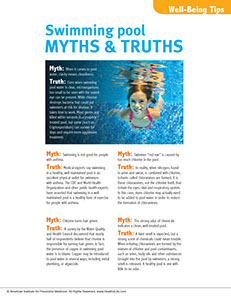SYMPTOM CHECKER
CONDITIONS
Male
Female
Child
Arm, Hand & Shoulder Concerns
Legs & Feet Concerns
Dental & Mouth Concerns
Ear & Nose
Eye Conditions
Head Conditions
Arm, Hand & Shoulder Concerns
Legs & Feet Concerns
Front
Back
Arm, Hand & Shoulder Concerns
Dental & Mouth Concerns
Ear & Nose
Eye Conditions
Head Conditions
Arm, Hand & Shoulder Concerns
Dental & Mouth Concerns
Ear & Nose
Eye Conditions
Head Conditions
Front
Back
Arm, Hand & Shoulder Concerns
Neck Links
Head & Neck Concerns
Arm, Hand & Shoulder Concerns
Neck Links
Head & Neck Concerns
Front
Back
Online Clinic
Wise Healthcare
Swimming pool myths & truths
Print on Demand
Myth: When it comes to pool water, clarity means cleanliness.
Truth: Even when swimming pool water is clear, microorganisms too small to be seen with the naked eye can be present. While chlorine destroys bacteria that could put swimmers at risk for disease, it takes time to work. Most germs are killed within seconds in a properly treated pool, but some (such as Cryptosporidium) can survive for days and require more aggressive treatment.
Myth: Swimming is not good for people with asthma.
Truth: Medical experts say swimming in a healthy, well-maintained pool is an excellent physical outlet for swimmers with asthma. The CDC and World Health Organization and other public health experts have asserted that swimming in a well-maintained pool is a healthy form of exercise for people with asthma.
Myth: Chlorine turns hair green.
Truth: A survey by the Water Quality and Health Council discovered that nearly half of respondents believe that chorine is responsible for turning hair green. In fact, the presence of copper in swimming pool water is to blame. Copper may be introduced to pool water in several ways, including metal plumbing, or algaecide.
Myth: Swimmer “red eye” is caused by too much chlorine in the pool.
Truth: In reality, when nitrogen, found in urine and sweat, is combined with chlorine, irritants called chloramines are formed. It is these chloramines, not the chlorine itself, that irritate the eyes, skin and respiratory system. In this case, more chlorine may actually need to be added to pool water in order to reduce the formation of chloramines.
Myth: The strong odor of chemicals indicates a clean, well-treated pool.
Truth: A faint smell is expected, but a strong scent of chemicals could mean trouble. When irritating chloramines are formed by the mixture of chlorine and pool contaminants, such as urine, body oils and other substances brought into the pool by swimmers, a strong smell is released. A healthy pool is one with little to no odor.
This website is not meant to substitute for expert medical advice or treatment. Follow your doctor’s or health care provider’s advice if it differs from what is given in this guide.
The American Institute for Preventive Medicine (AIPM) is not responsible for the availability or content of external sites, nor does AIPM endorse them. Also, it is the responsibility of the user to examine the copyright and licensing restrictions of external pages and to secure all necessary permission.
The content on this website is proprietary. You may not modify, copy, reproduce, republish, upload, post, transmit, or distribute, in any manner, the material on the website without the written permission of AIPM.
2021 © American Institute for Preventive Medicine - All Rights Reserved. Disclaimer | www.HealthyLife.com
















































